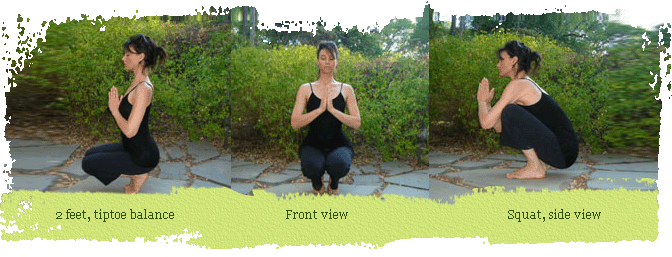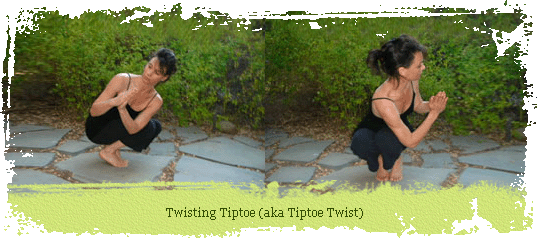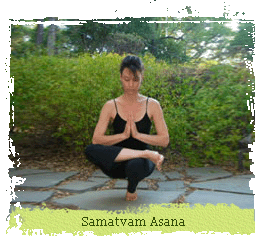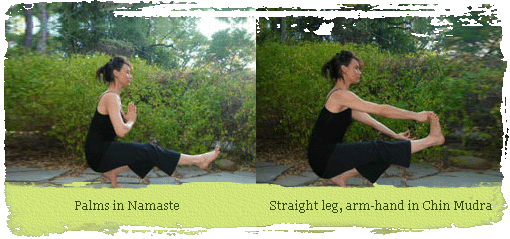Samatvam Asana - the Tiptoe Pose Yoga Journal Master Class
Yoga Journal Master Class
by Ganga White
March, 2008
On Your Toes
An ancient, oft-quoted, definition of yoga from the Bhagavad Gita is samatvam yoga uchyate (II.48), or “yoga is balance.” This verse emphasizes the central role of equilibrium both in yoga practice and in daily life. As students of yoga we seek to find physical, mental, and spiritual balance—and harmony—in our lives. However, we often objectify the idea of balance by using it as a noun. We say that we try to “attain” balance in our lives. But balance is not a static place to reach. Like an active verb, balance constantly balances and rebalances itself each moment in a moving equilibrium of relationships. us? itself? each moment. Balancing is a journey; not a destination.
Your personal journey into balance will not be found by following systematized or formulated modes of living and being; you will discover it by developing a sensitive awareness that responds and adjusts to the ever-shifting moment. Instead of seeking to attain balance, you will fare better by learning the art of balancing. Balancing involves correcting errors and then, in turn, involves correcting any overcorrection of those errors. Think about it in your asana practice: when you start moving or falling too far in one direction, you have to exert a bit of effort toward the other pole. You must balance and rebalance yourself as your ongoing corrections seek a natural harmony with your breath.
Learn to let your breath guide you toward a relaxed and responsive state of being in your poses as well as in your daily life. Notice how even, full inhalations and exhalations create a supple and centered body, while shortened or suspended breaths give way to sensations of rigidity and disconnection. When you refine the ability, to let your breath evenly and to balance and rebalance yourself, you will become more stable, and your movements and adjustments in each pose will become subtler. To an external observer you may appear to be still or “in balance,” but from the inside you will be able to feel the continual adjustments within this stability. You will feel the constant interplay of movement within stillness and stillness within movement.
All balancing postures provide an opportunity to learn and experience the dynamic nature of balance. Try a basic pose like Vrksasana (Tree Pose), a seemingly simple pose where you balance on one foot. No matter how still or statue-like you become, you will notice that you must continually listen, feel, and react responsively to each moment or you’ll lose your balance. Creating harmony in your life is similar: It implies tuning in, listening within and without, and working in concert with yourself and others. The constant ability to observe and harmonize internal awareness with outer actions through a steady breath and with the vigilance that we develop in these yogic postures becomes an invaluable asset in navigating the changing seas of life.
More challenging balance poses, such as Samatvam, turn up the volume so you can hear the dynamics involved in balancing loud and clear. To do Samatvam, the Tiptoe Pose, you begin in a squatting position by bending one leg and supporting it behind the other knee while sitting on your heel. All the body’s weight and entire center of balance must be maintained on the tiptoes on a raised ankle. This posture creates a very tricky physical form to balance in with only a single, very small contact point with the earth. It requires great focus and attention to maintain equilibrium. The technical difficulty of the posture’s strength and flexibility challenges, combined with the stillness of focus and constant subtleties of adjustment the balance requires, make this asana exhilarating to hold for even a few breaths. As you work on the poses in the sequence that follows don’t worry about being able to maintain perfect balance right away. Instead, use these poses as an opportunity to explore how balance works and be watchful of very subtle ways that your body moves to find balance. Your strength as well as your ability to tune into and adjust to small changes in equilibrium will improve your balance over time.
Pose 1. Vrksasana (Tree Pose)
With regular practice you can greatly improve and refine your ability to balance. A good way to warm up for Samatvam is by practicing Tree Pose and its variations. Before you begin, be sure that you have a solid foundation to practice on. Remember that creating a solid foundation is fundamental to all balancing poses. Whether the base of your pose is on your hands or feet, you’ll need a hard or firm surface to stand on, like a wood or tiled floor. Most carpeted surfaces are too soft, and sometimes even a thin yoga mat can be too unstable.
Stand with your feet together in Tadasana (Mountain Pose). Let your breath become even and rhythmic to help create mental focus and equilibrium. When you enter a balancing posture, move very slowly, with complete attention, and not any faster than you can maintain stability. Try not to think of the finished pose, instead see that each movement is steady and complete in itself.
From Mountain Pose, press your hands together in prayer position, or Namaste, at the chest and gently fix your gaze on a point on the floor a short distance in front of you. This dristhi, or gaze point, will help you maintain your focus. From there, shift your balance onto your right foot, then lift your left foot off the floor and press it into the root of your right leg. Hold the pose quietly and steadily, keeping your gaze point fixed and your breath even. Repeat on the other side, then practice changing sides a couple of times while carefully shifting your balance through the transitions, which will hone your awareness and abilities.
Tree Pose can be held quietly and passively like this, focusing mainly on steadiness and balance, or you can practice it more dynamically. When your Tree is steady, you can begin to intensify the pose by activating more muscle sets. Firmly press your hands together, tighten the buttocks, tuck your tailbone, and lift the chest to build strength and add a challenge. You can also actively extend your folded palms overhead, like limbs of a tree growing toward the light, to further increase the lively expression of this elegant asana.
A final and challenging variation of Vrksasana is to slowly come up on your tiptoes and practice maintaining a steady balance. This Tiptoe Tree variation will strengthen your ankles and prepare you for Samatvam Asana. Keep your standing foot pointing straight ahead and try lifting up and down a few times from flat foot to extended ankle to further tone and strengthen the ankle muscles.
To experiment with another threshold of balancing awareness, try holding the Tree with your eyes closed. There are three primary sensory systems used for balancing: visual perception, auditory perception, and the proprioceptive sites distributed throughout the body. Proprioceptors are sensory receptors, found in muscles, tendons, joints, and the inner ear, that detect the motion or position of the body. You can experiment by closing your eyes and trying to touch your nose with the tip of one finger. These sensory receptors are what are telling you the position of your body parts. By closing your eyes and shutting off external visual perception, you can increaseyour ability to listen to the breath and your proprioceptors to improve the function of your inner balancing systems With repeated practice your ability to listen and navigate toward balance will emerge from within.
Start by coming into the Tree, choosing a dhristi on the floor close to the tips of your toes. Then become as steady as possible with even breathing. Slowly let the eyelids relax and fall like soft curtains. Don’t shut them quickly or close them all the way, let them rest with a slight opening at the bottom so that you can still use a small portion of your visual perception for balance. Then, after a few more even breaths, withdraw even this remaining awareness and use of your eyes by closing them all the way. This practice will help you learn to develop and use your inner balancing mechanisms. You’ll get the hang of this with some experimentation and your inner balance will steadily improve.
Pose 2. Squatting Tiptoe Balance

This pose will strengthen your ankles and allow you to experiment with balance in a squatting position. Come into a squat with your feet flat on the floor if possible. (If you are unable to squat with flat feet, place a block or a folded mat under your heels.) Keep your feet parallel with the inner edges touching, or if you need to, bring them to hip distance apart. You may need to extend your arms in front of your knees at first to counterbalance your weight. Press your hands at the chest in Namaste and hold the pose for a few breaths. Next, rise up on the tiptoes of both feet, sitting on your heels, with your weight propped on each sit bone. Hold this for several steady, even breaths. Rise up and down a few times to further strengthen the ankles: when you rise up, your upper thighs and knees will come down parallel to the floor; when you go back to Squat, the knees will point upward. You can also try holding the Squatting Tiptoe with closed eyes, as explained above, and you may find it easier to balance here than it was in the Tree.
Pose 3. Twisting Tiptoe Pose

Adding a twist into this asana is a good variation of the Squatting Tiptoe because it requires heightened balance awareness to make this movement and it gives a nice rotational adjustment to the spine while opening your hips for Samatvam. Come into the raised Tiptoe Pose with ankles extended. Steady yourself while balancing on both feet. Now twist slowly to your right as you breathe out. Bring the back of your left upper arm over the right thigh and press it against the outside edge of that thigh. Press your palms firmly together and lift your chest to increase extension and the space between your vertebrae while twisting. Turn your head naturally to the right and find a comfortable gaze point on the floor or side wall. Hold for twenty to thirty seconds, or to your own comfort level, and then change sides.
A further variation of the basic twisting squat known as Noose Pose, or Pasasana, involves wrapping the forward arm in front of your shinbones while taking the back arm around behind you and clasping hands. This type of binding requires considerable flexibility and I generally caution against risking the arm lock in twisting poses. Even for very flexible people, such binding exerts an undesirable outward torque on the shoulder cuff that can lead to instability and injury. Binding would be even riskier in a balancing Tiptoe twist. You twist just as effectively and beneficially by pressing the hands and lifting the chest as you rotate.
Pose 4. Tiptoe Pose (Samatvam Asana)

Now you’re ready to move into Samatvam Asana. From the squatting position up on your tiptoes, place your right heel toward the center of your pelvis and sit on the heel. Where you press the heel will depend on your anatomy, so experiment until you find a placement that’s comfortable for you. Most people are able to press the heel against the tailbone or center it in the perineum area to distribute the weight between both sitting bones. Some people find they must keep the heel to one side supporting their weight right on the sitting bone.
Once you’ve found a suitable place for your heel, cross one leg over the opposite thigh and support it just behind the knee by lifting your right foot off the floor and, with the knee bent, externally rotating the leg and placing your left ankle just below your right knee. . If possible, keep the shinbone parallel to the floor. While coming into Samatvam, prop yourself up by keeping your fingertips, of one or both hands, on the floor to the side of your thighbones. Then you can slowly lift your hands off the floor, using them like training wheels as you learn to balance. Try to hold the pose for a few breaths and then changes sides. Changing sides back a forth a few times after holding can help you improve. Keeping your breathing smooth and even improves concentration and balance.
Samatvam Variations:
Once you are able to balance on the ball of either foot, explore the three different arm-hand positions available for this posture. The first works a bit like a tight-rope walker’s weighted balancing bar: You reach the arms straight out to each side and pointed downward with palms up and the hands in chin mudra—index finger touching the thumb with the other fingers extended outward.
Next, try bringing the hands closer to your balancing centers with palms folded at the chest in Namaste. Lastly, extend the energy of balance skyward by raising your arms overhead with palms in Namaste. Each of these arm positions develops a slightly different balance awareness and it is enjoyable to do them all. Work up to holding Tiptoe Pose for several slow breaths, or about thirty seconds on each side. You may also experiment with closing your eyes.
Palms in Namaste Straight leg, arm-hand in Chin Mudra 
For the final variation in this series, you will extend one leg forward while in a Tiptoe balance. Start in Tiptoe Pose on both feet. Support yourself with your hands on each side, extend your left leg and sit on your right heel, pressing it in the same spot you used in the previous pose. Extend strong lines of energy through your foot by reaching the ankle forward and flexing the toes back. As you steady yourself, balance with your arms down and out toward the sides with hands in Chin Mudra. You can also hold with your palms folded in Namaste at your heart center. For another variation clasp the big toe or outside edge of the extended foot with the hand from the same side and balance with the other hand down and out in Chin Mudra.
Enjoy the equilibrium you discover!
Maintaining balance and equilibrium is one of the precious goals in yoga. This challenging pose of equilibrium can help you recognize that balance is not a fixed place at which you arrive, but a journey of constant adjustment, sensitivity, and responsiveness to the changing circumstances of each moment. Our busy, modern lives cause many of us to seek to reestablish wholeness through exercise, right eating, and inner work. It is all too easy to overfill our days with constant input and activity and all too rarely take the time to tune in to the balance present in the natural world around us. An integral part of the teachings at White Lotus emphasizes the great lessons we learn about the nature of balance by meditating in and observing the balance of nature.
Hatha yoga, the yoga of Sun and Moon, reminds us that many opposites naturally balance each other. Our breath constantly balances our existence with the greater equilibriums of nature and life, and reminds us of our interconnectedness with all things.. By practicing balancing poses, guided by the dance of inward and outward currents in the flow of breath, we can learn to become aware of and to balance faith with questioning, pushing through with backing off, control with surrender, left with right, back bending with forward bending, upward moving energy with downward energy, softness with firmness, strength with flexibility, heating with cooling, activity with rest, and masculine with feminine--to name a few of the important polarities that inform and guide our lives.
The breath is a constant reminder of balancing the inward and outward, expansion and contraction, filling and emptying, assimilation and elimination, the outer with the inner and the breath continually reminds us of our connection with all things and of the balance the breath is always creating.
Samatvam asana, the Tiptoe Pose, dramatizes the interplay of the stillness of focus and motionlessness in harmony with the constant movement and adjustment that balancing requires. The challenges this pose and its variations present give us ample opportunity to enhance our awareness of balancing dynamics and to rehearse our life skills for harmony.
Ganga White is author of Yoga Beyond Belief—Insights to Awaken and Deepen Your Practice and co-director of White Lotus Yoga Foundation retreat.
